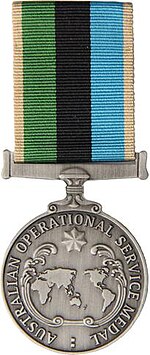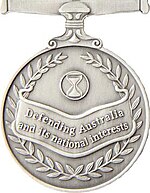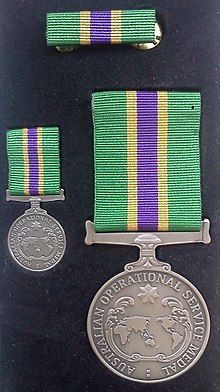| Australian Operational Service Medal | |
|---|---|
  Australian Operational Service Medal with: "Border Protection" ribbon (top) and "Greater Middle East Operation" ribbon | |
| Type | Campaign medal |
| Awarded for | Service on declared hazardous operations |
| Presented by | Australia |
| Eligibility | Military – Willingly and ably perform their work as part of an operation or within other specific hazardous environments and conditions. Civilian – Defence civilians, and other classes of civilian who are employed on ADF operations under the provisions of the Defence Force Discipline Act 1982. [1] |
| Clasps | "accumulated service device" for military awards [2] [3] Clasps for operations for civilian awards [2] [4] |
| Status | Currently issued |
| Established | 22 May 2012 |
| First award | 12 December 2012 [5] |
 Reverse | |
| Order of Wear | |
| Next (higher) | Australian Service Medal |
| Next (lower) | Rhodesia Medal |

The Australian Operational Service Medal is a campaign medal established on 22 May 2012 to recognise service by Australian Defence Force (ADF) personnel on designated hazardous operations. It may also be awarded to civilians who serve alongside the ADF on designated operations under specific conditions.
Contents
- Overview
- Military version
- Civilian version
- Variants for declared operations – Military version
- Australian Operational Service Medal – Border Protection (AOSM-BP)
- Australian Operational Service Medal – Greater Middle East Operation (AOSM-GMEO)
- Australian Operational Service Medal – Africa (AOSM-A)
- Australian Operational Service Medal – Indo–Pacific (AOSM-IP)
- Clasps for declared operations – Civilian version
- See also
- References
- External links
It replaces the Australian Active Service Medal and Australian Service Medal for future ADF operations. The medal is issued to military personnel with a different ribbon for each designated operation. When issued to civilians, a standard ribbon is issued with clasps issued for each designated operation.
